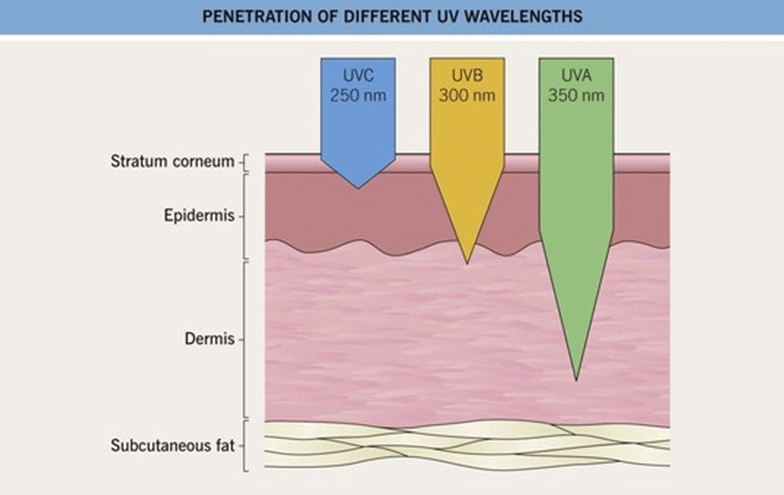Almost All Of The Ultraviolet Radiation
Uv radiation is divided into three ranges uv a 315 to 400 nm uv b 280 to 315 nm and uv c 100 to 280 nm. Some uv radiation visible light and ir radiation can reach the retina.
Uv c and almost all uv b are absorbed in the cornea of the eye.
Almost all of the ultraviolet radiation. This helps the body to retain its folate reserves and. Uv a passes through cornea and is absorbed in the lens of the eye. Almost all of the ultraviolet radiation.
Uv c and almost all uv b are absorbed in the cornea of the eye. By the time modern homo sapiens evolved all humans were dark skinned. Humans with dark skin pigmentation have skin naturally rich in melanin especially eumelanin and have more melanosomes which provide a superior protection against the deleterious effects of ultraviolet radiation.
Ultraviolet uv is electromagnetic radiation with wavelength from 10 nm to 400 nm shorter than that of visible light but longer than x raysuv radiation is present in sunlight and contributes about 10 of the total electromagnetic radiation output from the sunit is also produced by electric arcs and specialized lights such as mercury vapor lamps tanning lamps and black lights. Each water droplet in a cloud scatters some incoming uv radiation back into space so a thick cover of clouds protects organisms and materials from almost all uv. Chlorine then breaks one oxygen atom away from ozone leaving behind a paired oxygen molecule.
Uv a passes through cornea and is absorbed in the lens of the eye. By the time sunlight reaches the top of the stratosphere at about 30 miles altitude almost all the radiation shorter than 1900 a has been absorbed by molecules of nitrogen and oxygen. Little of the ultraviolet radiation.
Cloud cover plays a highly influential role in the amount of both uv a and uv b radiation reaching the ground. What is another name for the ozone layer. Individual oxygen atoms bond.
The first way is by measuring it directly with instruments on the ground. How is the ozone formed in the stratosphere. What would happen to the oxygen atoms in ozone if the ozone layer were completely destroyed by ultraviolet radiation.
These ground based instruments can tell us the amount of uv b radiation reaching the surface at their exact locations. How much ultraviolet uv b radiation are we getting. Ultraviolet radiation breaks apart molecules made up of paired oxygen atoms.
Scientists determine uv b exposure at the surface in two ways. Ultraviolet radiation breaks down cfcs molecules containing chlorine. The ozone layer effectively blocks almost all solar radiation of wavelengths less than 290 nanometres from reaching earths surface including certain types of ultraviolet uv and other forms of radiation that could injure or kill most living things.
Fortunately because of the earths atmosphere only a trace of this dangerous ultraviolet radiation actually reaches the earth. What are the symptoms of arc. Uv radiation is divided into three ranges uv a 315 to 400 nm uv b 280 to 315 nm and uv c 100 to 280 nm.
Ionosphere ozonosphere troposphere oxysphere stratosphere. Some uv radiation visible light and ir radiation can reach the retina.
Why Black Lights Make Things Glow
www.todayifoundout.com
Light And Eye Damage Pdf Free Download
docplayer.net
Sunglasses Mavor Optical
mavoroptical.com
 The Different Types Of Electromagnetic Radiation
The Different Types Of Electromagnetic Radiation
www.zmescience.com
 What You Should Know Before Buying Sunglasses
What You Should Know Before Buying Sunglasses
www.fox4now.com
 The 3 Types Of Uv Rays Montrose Dermatology
The 3 Types Of Uv Rays Montrose Dermatology
www.montrosedermatology.com
 The Dynamic Earthsection 2 The Atmosphere The Atmosphere Is A
The Dynamic Earthsection 2 The Atmosphere The Atmosphere Is A
slideplayer.com
 Protecting Your Eyes From The Sun Sunglasses Uv Protection
Protecting Your Eyes From The Sun Sunglasses Uv Protection
www.johnoconnor.co.nz
 Low Maternal Exposure To Ultraviolet Radiation In Pregnancy Month
Low Maternal Exposure To Ultraviolet Radiation In Pregnancy Month
www.bmj.com
0 Response to "Almost All Of The Ultraviolet Radiation"
Post a Comment